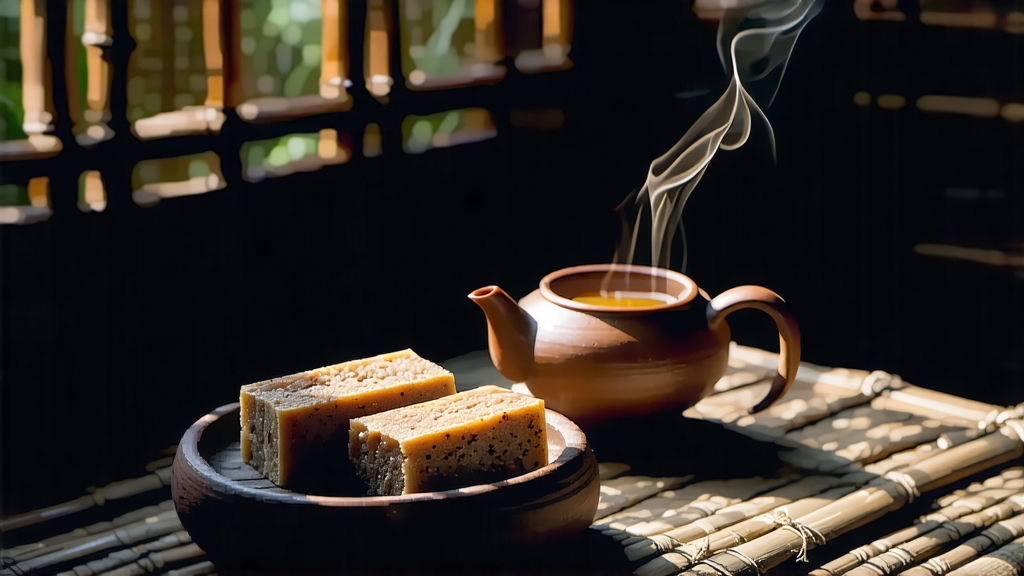
Tucked away in the subtropical mountains of southern China’s Guangxi Zhuang Autonomous Region, Liu Bao tea has spent four centuries perfecting the art of quiet transformation. While Pu-erh has become the global shorthand for “Chinese dark tea,” Liu Bao—older by a generation—remains the insider’s secret, a tea whose mellow, betel-nut sweetness and ruby-amber liquor reward the patient traveler. This article invites the international reader to discover Liu Bao’s history, craftsmanship, and the sensory ritual that turns a compressed leaf into liquid time.
-
From Border Trade to Imperial Tribute
Liu Bao takes its name from the old Liu Bao township of Wuzhou prefecture, once the last navigable port on the Xun River before the rapids of Guangdong. During the late Ming dynasty (17th c.), flat-bottomed boats carried rice, medicinal herbs, and rough-hewn tea southward to Guangzhou’s foreign warehouses. The tea—sun-withered, pan-fired, and steamed into 40-kilo bamboo baskets—arrived darker and smoother than when it left, the three-week river journey acting as a mobile fermentation chamber. By the Qing Qianlong era (1736–95), Liu Bao’s ability to calm stomachs in the humid delta had earned it imperial tribute status; court records list “Cangwu dark tea” dispatched to Beijing’s palace pharmacies. In the 19th century the British East India Company re-exported it to Malaya, where tin-mine coolies drank it to prevent malaria; thus Liu Bao crossed the South China Sea decades before Pu-erh ever saw a Hong Kong tea house. -
Terroir: The Microbial Grand Cru
Guangxi’s karst peaks trap monsoon clouds, creating year-round humidity above 80 % and mean temperatures of 22 °C—ideal for the slow, microbial post-fermentation that defines dark tea. The indigenous large-leaf variety, Camellia sinensis var. assamica cv. Guangxi Daye, grows between 300–800 m on lateritic red soils rich in iron and potassium. These leaves are naturally higher in polyphenols and pectin than Yunnan’s Yunkang #10, giving Liu Bao its thicker body and signature “betel-nut” note—a cooling, camphoraceous sweetness reminiscent of areca palm seeds chewed across Southeast Asia. -
Craftsmanship: The Bamboo-Basket Dance
Liu Bao’s processing follows a six-step choreography unchanged since 1860:
a. Plucking: One bud with three to four leaves in early April, when amino acids peak.
b. Solar Withering: Leaves are spread on hemp cloth for 4–6 h until 65 % moisture remains, developing grassy floral precursors.
c. Kill-Green: A 280 °C wok roast for 3 min deactivates enzymes yet preserves pectin for later microbial adhesion.
d. Rolling: A 40-min low-pressure roll breaks 35 % of cell walls, enough to release sap without pulverizing the leaf.
e. Wet-Pile Fermentation (Duīwò): Unique among dark teas, Liu Bao uses a “short pile” (15–20 days) at 45 °C and 75 % RH, lighter than Pu-erh’s 60-day wo-dui, yielding a cleaner, less earthy profile. Indigenous strains of Aspergillus niger and Blastobotrys adeninivorans dominate, metabolizing caffeine into the bronchodilator theacrine and creating the tea’s ruby color.
f. Bamboo-Basket Compression & Loft Aging: Semi-fermented tea is steamed for 90 s, packed into 50 cm-tall cylinders lined with fresh bamboo bark, and laced with rattan. These baskets are stacked in riverside warehouses where natural convection cycles humid air through the leaves for a minimum of three years; vintage grades see fifteen or more. Bamboo’s soluble lignins seep into the tea, adding a whisper of green coconut that old-school Cantonese call “bamboo nectar.”
- Grades & Vintage Codes
Liu Bao is classified by leaf maturity and aging period:- First Grade (Teji): golden tips, 3-year loft, cocoa and dried longan.
- Third Grade (Sanji):